I am in the process of trying to decide on a new scope. This will be my first high end scope. I am prepared to spend at least 2000.00 but would go higher if the scope fits my needs. It will go on an SPS Tactical 308. I am a hunter and also enjoy shooting targets out to 510 yards but I am working on a place where I can shoot to 1000 yards. My question is a FFP going to cover up too much of the target to make precise shots when shooting groups? This is a tough decision for me because the FFP choices often come with more advanced and more functional reticles. Any tips and advice would be very helpful.
Join the Hide community
Get access to live stream, lessons, the post exchange, and chat with other snipers.
Register
Download Gravity Ballistics
Get help to accurately calculate and scope your sniper rifle using real shooting data.

Install the app
How to install the app on iOS
Follow along with the video below to see how to install our site as a web app on your home screen.
Note: This feature may not be available in some browsers.
-
Get 25% Off Access To Frank's Online Training
Use code FRIDAY25 and SATURDAY25 to get 25% off access to Frank’s online training. Want a better deal? Subscribe to get 50% off.
Get Access Subscribe
You are using an out of date browser. It may not display this or other websites correctly.
You should upgrade or use an alternative browser.
You should upgrade or use an alternative browser.
Rifle Scopes Is FFP Even an Option for Target Shooters
- Thread starter Nosler243Shooter
- Start date
Re: Is FFP Even an Option for Target Shooters
I reckon it's all based on reticle choice. A FFP scope I have that is phenomenal for shooting groups during load development is a USO 17x with RDPMOA reticle. Subtension is 0.07 IPHY. I can center a 30 cal bullet hole at 200 with this reticle.
I've been just as capable of centering a 0.5" dot at 200 yards with the USO PCMOA reticle rated at 0.12 MOA (0.115 IPHY) and the 0.04 Mil (0.144 IPHY) rated Gen 2 XR. The XR is thicker but easier to center because of glass quality. At longer distance, no issues centering a 8" steel disc at 700+ yards with the XR.
I reckon it's all based on reticle choice. A FFP scope I have that is phenomenal for shooting groups during load development is a USO 17x with RDPMOA reticle. Subtension is 0.07 IPHY. I can center a 30 cal bullet hole at 200 with this reticle.
I've been just as capable of centering a 0.5" dot at 200 yards with the USO PCMOA reticle rated at 0.12 MOA (0.115 IPHY) and the 0.04 Mil (0.144 IPHY) rated Gen 2 XR. The XR is thicker but easier to center because of glass quality. At longer distance, no issues centering a 8" steel disc at 700+ yards with the XR.
Re: Is FFP Even an Option for Target Shooters
It all depends on the reticle thickness.
I would suggest staying under .1 mil thick reticle.
.1 mil will cover 3.6" at 1000yds.
I prefer a reticle in the .05-.06 range for long range targets and doubling as a big game hunting reticle.
It all depends on the reticle thickness.
I would suggest staying under .1 mil thick reticle.
.1 mil will cover 3.6" at 1000yds.
I prefer a reticle in the .05-.06 range for long range targets and doubling as a big game hunting reticle.
Re: Is FFP Even an Option for Target Shooters
I use the .15" (tiny) floating dots at the 1/2 mil point in the Horus H-58/59 reticle for groups. Dial to the preferred dot and rock on.
Vortex reticles have small dots as well.
I use the .15" (tiny) floating dots at the 1/2 mil point in the Horus H-58/59 reticle for groups. Dial to the preferred dot and rock on.
Vortex reticles have small dots as well.
Re: Is FFP Even an Option for Target Shooters
I've only ever used FFP scope shooting out to 1k and the reticle covering the target has never been an issue. Check out the Nightforce NXS F1 with the MLR2.0 reticle. Just got it for my .308 and it's awesome.
I've only ever used FFP scope shooting out to 1k and the reticle covering the target has never been an issue. Check out the Nightforce NXS F1 with the MLR2.0 reticle. Just got it for my .308 and it's awesome.
Re: Is FFP Even an Option for Target Shooters
There are plenty of FFP reticles that work great for simple target shooting, but in general, are totally unnecessary.
My Bender 5-25 P4F reticle, and Gen 2XR do great for F class, whose targets have a 1/2 moa X ring, and a 1 moa 10 ring.
F class is a secondary game for me - an excuse to go out and shoot at distance. If target shoiting was my MAIN priority, and I wanted a highend optic, I'd choose a Nightforce or March.
You could honestly do very, very well with the Nightforce Benchrest model in 8-32 or 12-42, and spend a LOT less monet. They can be had used for ~$1100 or new for ~$1300 I think. Great scopes, just not "tactical".
There are plenty of FFP reticles that work great for simple target shooting, but in general, are totally unnecessary.
My Bender 5-25 P4F reticle, and Gen 2XR do great for F class, whose targets have a 1/2 moa X ring, and a 1 moa 10 ring.
F class is a secondary game for me - an excuse to go out and shoot at distance. If target shoiting was my MAIN priority, and I wanted a highend optic, I'd choose a Nightforce or March.
You could honestly do very, very well with the Nightforce Benchrest model in 8-32 or 12-42, and spend a LOT less monet. They can be had used for ~$1100 or new for ~$1300 I think. Great scopes, just not "tactical".
Re: Is FFP Even an Option for Target Shooters
<div class="ubbcode-block"><div class="ubbcode-header">Originally Posted By: steve123</div><div class="ubbcode-body">I use the .15" (tiny) floating dots at the 1/2 mil point in the Horus H-58/59 reticle for groups. Dial to the preferred dot and rock on.
Vortex reticles have small dots as well. </div></div>
This.
If you split your time between target shooting and competition/UKD, it makes a lot of sense to get an FFP scope with a reticle that supports this technique. I spend 90% of my time shooting from the bench, so I went with an SFP NF, but my close 2nd option was a Razor HD with the EBR2 MRAD reticle. Dial the scope "down one, over one" and you can easily use a very fine dot for your target shooting. Best of both worlds.
<div class="ubbcode-block"><div class="ubbcode-header">Originally Posted By: steve123</div><div class="ubbcode-body">I use the .15" (tiny) floating dots at the 1/2 mil point in the Horus H-58/59 reticle for groups. Dial to the preferred dot and rock on.
Vortex reticles have small dots as well. </div></div>
This.
If you split your time between target shooting and competition/UKD, it makes a lot of sense to get an FFP scope with a reticle that supports this technique. I spend 90% of my time shooting from the bench, so I went with an SFP NF, but my close 2nd option was a Razor HD with the EBR2 MRAD reticle. Dial the scope "down one, over one" and you can easily use a very fine dot for your target shooting. Best of both worlds.
Re: Is FFP Even an Option for Target Shooters
What size reticle is on the new NF FFP scope? I want a scope to shoot about 2000 yards, should I stick with a SFP scope? I've been planning on the NF NSX 5.5-22x56 mil/mil
What size reticle is on the new NF FFP scope? I want a scope to shoot about 2000 yards, should I stick with a SFP scope? I've been planning on the NF NSX 5.5-22x56 mil/mil
Re: Is FFP Even an Option for Target Shooters
I think you are misunderstanding a few things. Reticles in FFP optics ALWAYS cover the same amount of area, no matter what magnification they are set to. Where as the reticles on SFP optics cover variable amounts of area dependent upon magnification. As for which is better. Personally I would never go back to a SFP design but some BR guys would not be caught dead with a FFP scope. It is all about usage. I actually use my ranging reticle where as guys in the BR world that shoot only at known distances targets don't really utilize this feature. Hints the preferences.
I think you are misunderstanding a few things. Reticles in FFP optics ALWAYS cover the same amount of area, no matter what magnification they are set to. Where as the reticles on SFP optics cover variable amounts of area dependent upon magnification. As for which is better. Personally I would never go back to a SFP design but some BR guys would not be caught dead with a FFP scope. It is all about usage. I actually use my ranging reticle where as guys in the BR world that shoot only at known distances targets don't really utilize this feature. Hints the preferences.
Re: Is FFP Even an Option for Target Shooters
<div class="ubbcode-block"><div class="ubbcode-header">Originally Posted By: 243Varminter</div><div class="ubbcode-body">I am in the process of trying to decide on a new scope. This will be my first high end scope. I am prepared to spend at least 2000.00 but would go higher if the scope fits my needs. It will go on an SPS Tactical 308. I am a hunter and also enjoy shooting targets out to 510 yards but I am working on a place where I can shoot to 1000 yards.</div></div>
When it comes to FFP scopes' there will always be a compromise for shooting activities. A FFP reticle that excels for hunting and tactical shooting is easy-to-see at low magnification against dark targets and backgrounds - even in very low light. However, that same reticle can become a liability when shooting small targets (think 1/2 MOA and smaller). A FFP reticle that is very fine and allows precise aiming at high magnification and excels at shooting small targets at distance is typically very difficult to see at low magnification against dark targets and backgrounds - especially in low light.
Striking a fine usability balance in a FFP reticle is difficult and few reticles do it well - especially when illumination is an option. For instance, the reticle thickness between an illuminated and a non-illuminated version of a reticle is sometimes thicker (even at the same power and with the illuminated turned-off) some scopes. It depends unpon the manner in which the reticle is etched into the lens as well as the substance that is deposited into the reticle. The less luminous the substance deposited into the reticle is, the thicker the reticle has to be in order for the reticle to be seen <span style="font-weight: bold">whether the illumination is <span style="font-style: italic">"On"</span> or <span style="font-style: italic">"Off"</span></span>. I don't know if this is still the case at USO, but when a friend of mine ordered a USO SN-3 T-PAL 3.2X-17X44mm with an illuminated MD MOA reticle several years ago it was. Even with the illumination cranked-up on his USO SN-3 T-PAL 3.2X-17X44mm the reticle never became brighter than a faint glow.
<div class="ubbcode-block"><div class="ubbcode-header">Originally Posted By: 243Varminter</div><div class="ubbcode-body">My question is a FFP going to cover up too much of the target to make precise shots when shooting groups? This is a tough decision for me because the FFP choices often come with more advanced and more functional reticles. Any tips and advice would be very helpful. </div></div>
Personally, while SFP scopes still have their place, now that I've owned and used FFP scopes I only buy FFP now. However, as I mentioned above there is a fine balance between reticle thickness and subtension and usability for various shooting activities, and your decision should be based on what you plan to do with your rifle and scope combination.
There are few FFP reticles that are fine enough that they don't obscure a significant amount of very small targets, but they do exist. In MIL-based FFP reticles, the reticle with the thinnest reticle, ie. the finest subtension, is the Premier Reticles Gen 2 XR at .075" at 100 yards <span style="font-weight: bold"><span style="font-style: italic">(3/4 of 1/10th" at 100 yards)</span></span>. Next up would be the S & B P4F. These two reticles are great in 5-25X[56mm] PMIIs', but are hard-to-see at 10X and below in low light - especially the Gen 2 XR.
If you're interested in PMIIs' in 3-12X and/or 4-16X the Premier Reticles Gen 2 XL or a standard P4 or P3 would be preferred, unless you happen upon a used Gen 2 XL. In case you're unaware, the Gen 2 XL and Gen 2 XR are no longer options in new PMII scopes. However, occasionally scopes with these reticles come up for sale here in the SH classifieds. If you're looking at Premier scopes you can get the Gen 2 and Gen 2 XR.
<span style="font-weight: bold"><span style="font-style: italic">I want to point-out that according to Premier PDFs' the line thicknesses of the Gen 2 XR in PMIIs' are the same across the model magnification ranges, but in Premier Heritage Gen 2 XR scopes' that IS NOT the case. Referencing dimensions "K" and "N" in the diagrams below you can see that the line thicknesses of the Heritage 3-15X Gen 2 XR are thicker than those of the Heritage 5-25X Gen 2 XR at the same locations:</span></span>
<span style="font-weight: bold"><span style="font-style: italic">PMII 4-16X / 5-25X Gen 2 XR Reticle diagram courtesy of Premier Reticles:</span></span>
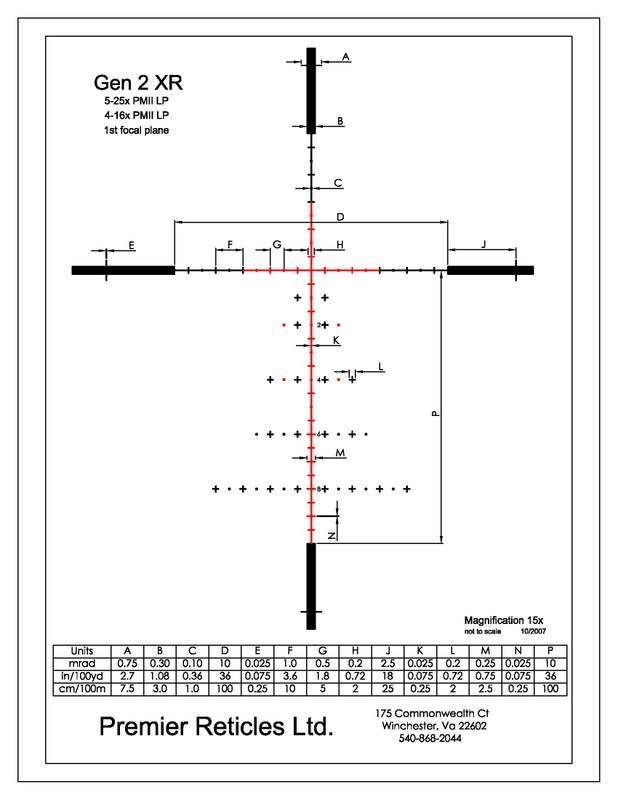
<span style="font-weight: bold"><span style="font-style: italic">PMII P4L (P4F Lighted) Reticle diagram courtesy of Schmidt Bender:</span></span>
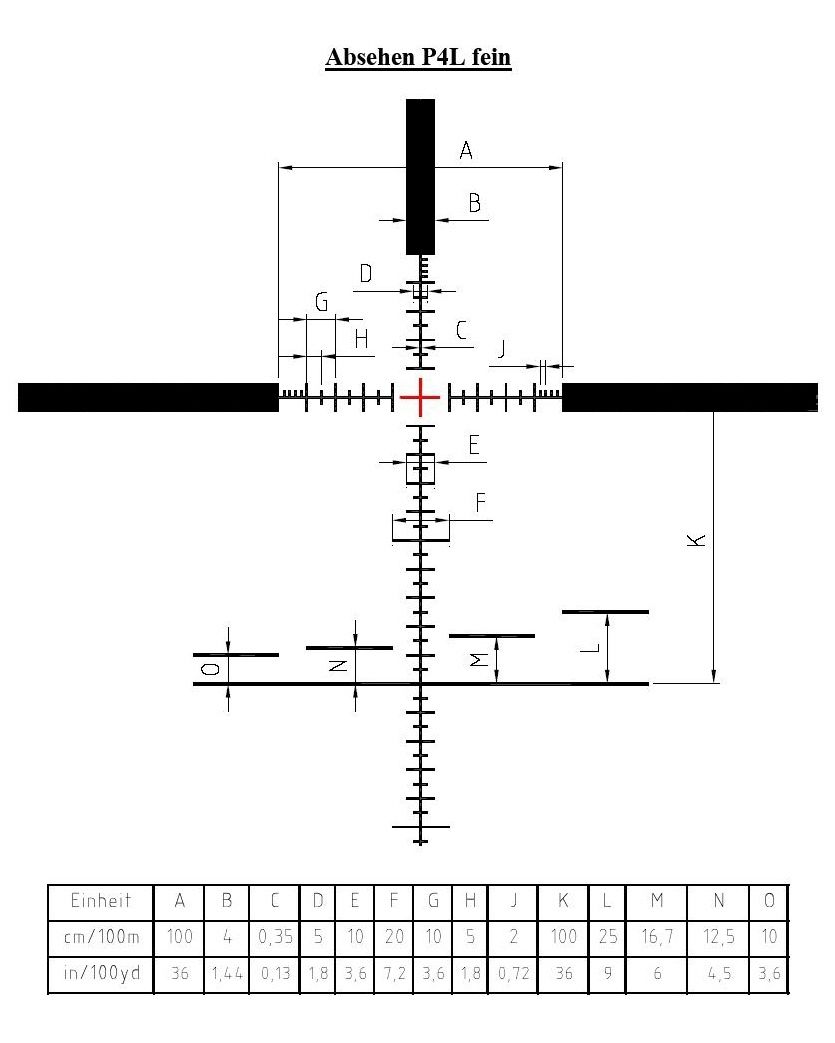
<span style="font-weight: bold"><span style="font-style: italic">Premier Heritage 3-15X Gen 2 XR Reticle diagram courtesy of Premier Reticles:</span></span>
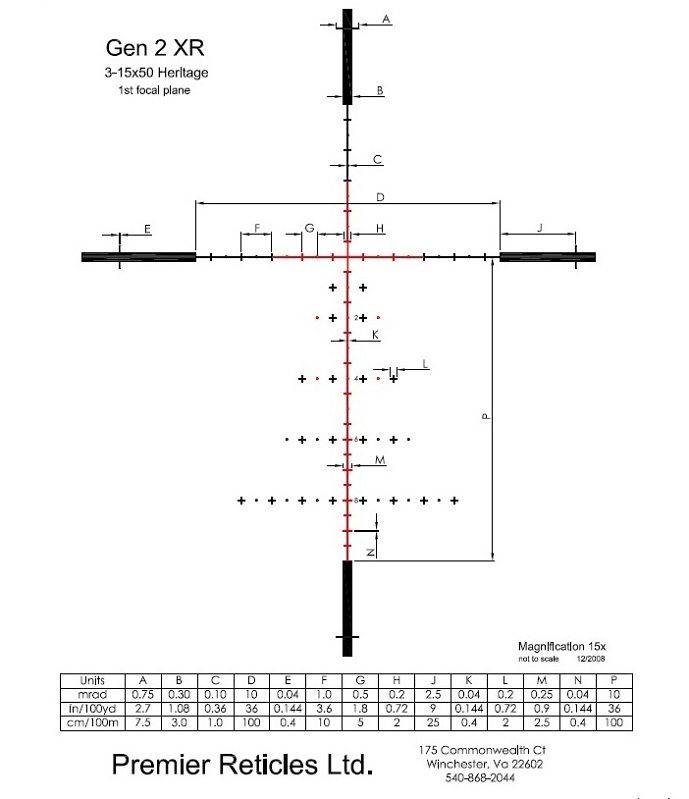
<span style="font-weight: bold"><span style="font-style: italic">Premier Heritage 5-25X Gen 2 XR Reticle diagram courtesy of Premier Reticles:</span></span>
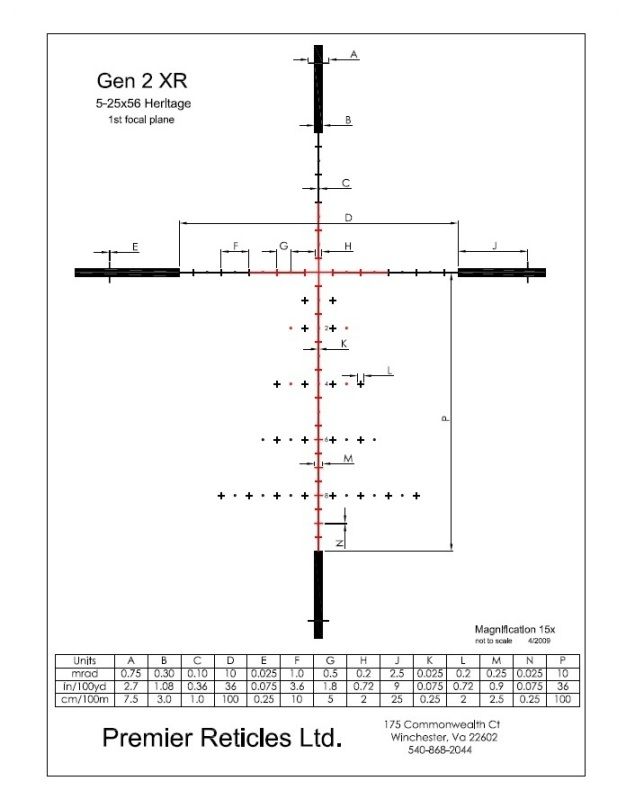
In MOA-based reticles the reticle with the thinnest reticle, i.e., the finest subtension, <span style="font-style: italic">(according to USO's RDP MOA diagram)</span> - is the <span style="font-weight: bold"><span style="font-style: italic">UNLIT Center</span></span> of USO's RDP MOA reticle (.07 MOA). <span style="font-weight: bold"><span style="font-style: italic">The Main Line width/thickness is .125 MOA.</span></span> USO's reticle with the thinnest <span style="font-style: italic">constant</span> Main Line thickness is the MIL-based GAP Reticle, which is still my favorite USO-designed reticle (0.1 MOA Main Line thickness at 100 yards). Depending upon whether the USO GAP and Schmidt Bender P4FL MOA are both actually MOA-based, (most of USO's "MOA" turrets and reticles are actually IPHY (Inch-Per-Hundred-Yards) based, while the MOA-based turrets on PMII are actually MOA-based. Therefore, the MIL-based GAP Reticle is either just ahead of or in a tie with the PMII's P4FL MOA <span style="font-style: italic">(theorietically 0.1 MOA Main Line thickness at 100 yards).</span>
<span style="font-weight: bold"><span style="font-style: italic">USO RDP MOA reticle diagram courtesy of U.S. Optics:</span></span>
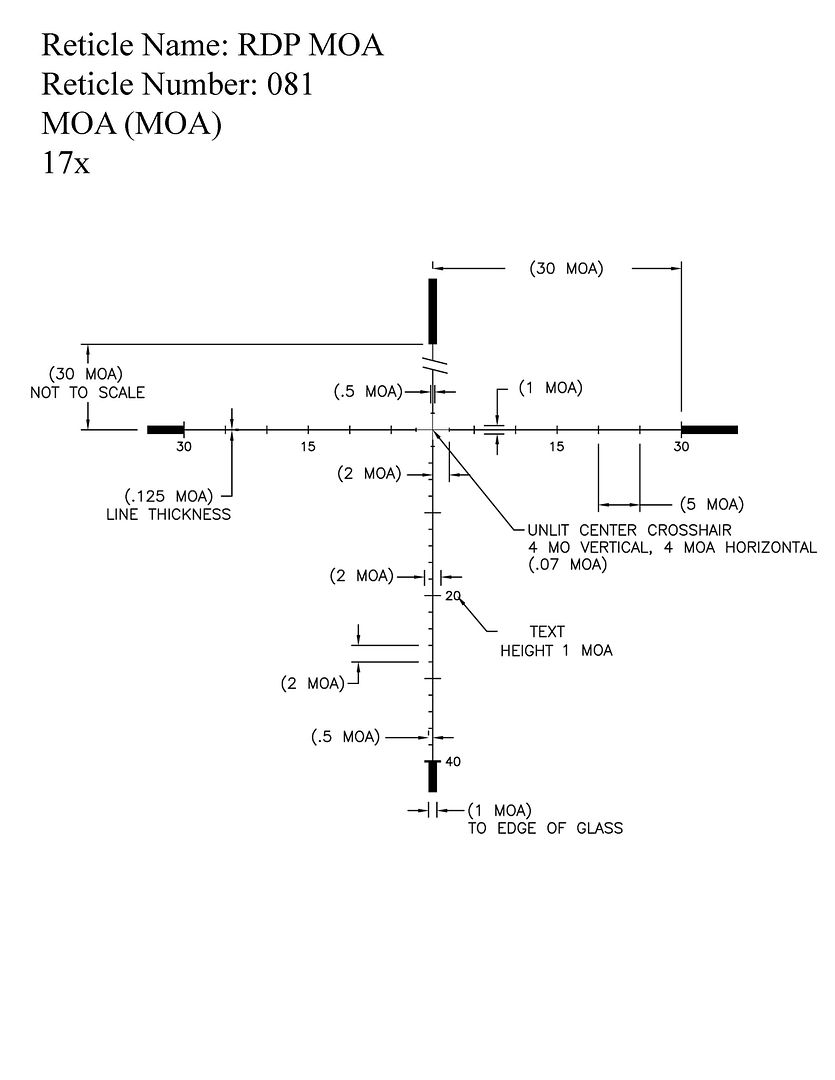
<span style="font-weight: bold"><span style="font-style: italic">USO MIL-based GAP reticle diagram courtesy of U.S. Optics:</span></span>
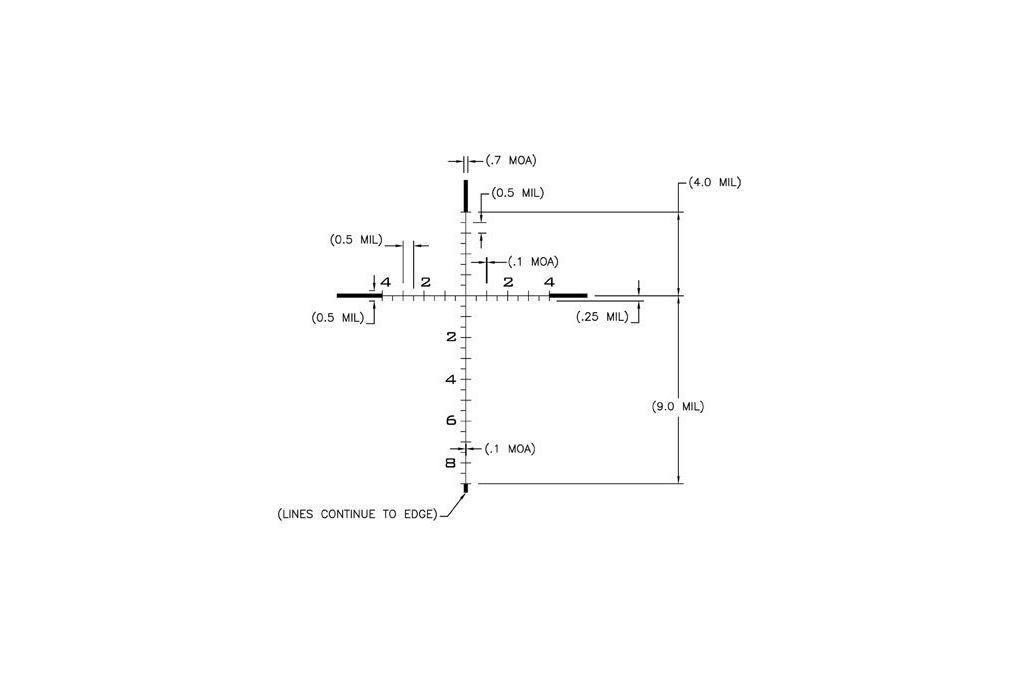
The second-thinnest MOA-based FFP reticle is the MOA-based version of the P4F at .1 MOA/.1047" - <span style="font-weight: bold"><span style="font-style: italic">(just over 1/10th" at 100 yards).</span></span>
<span style="font-weight: bold"><span style="font-style: italic">PMII 3-12X P4L MOA Reticle diagram courtesy of Schmidt Bender:</span></span>
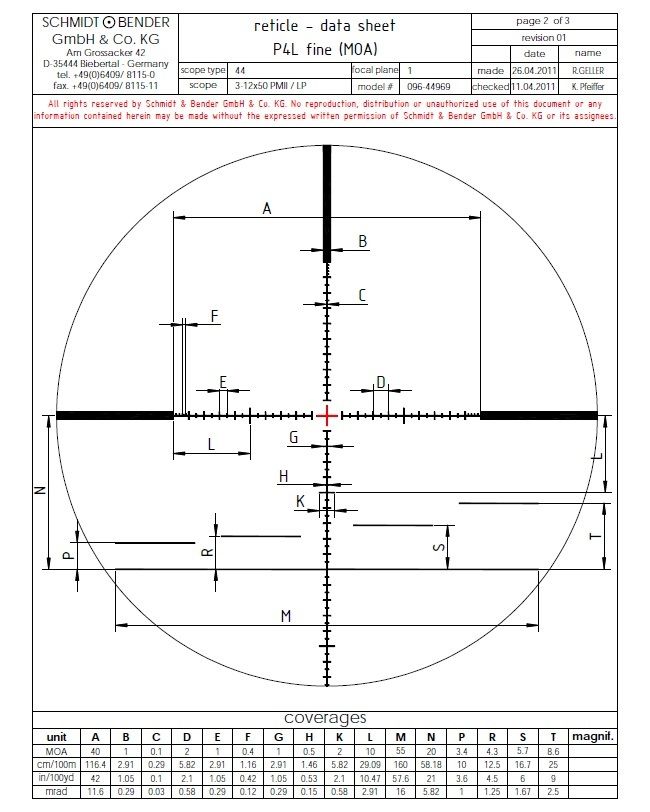
<span style="font-weight: bold"><span style="font-style: italic">PMII 5-25X P4L MOA Reticle diagram courtesy of Schmidt Bender:</span></span>
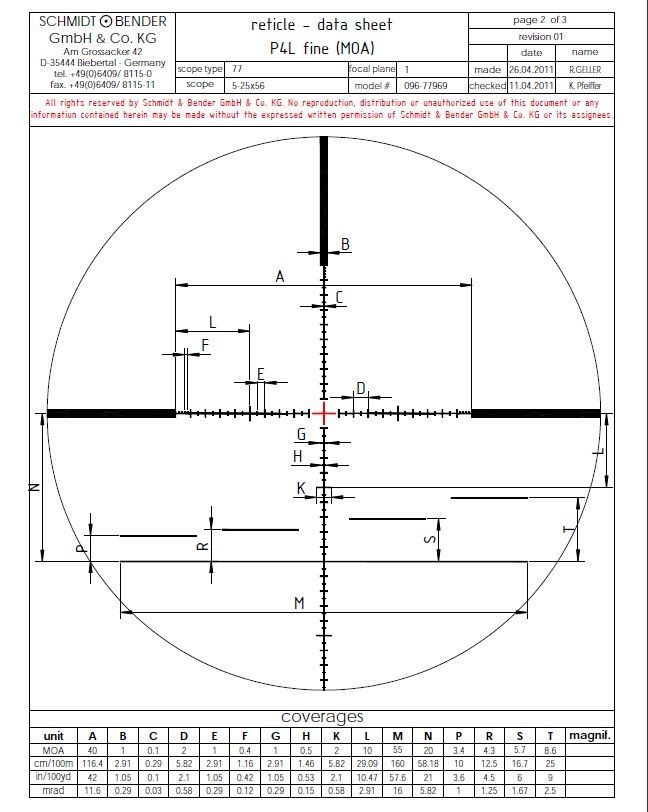
Obviously, a hands-on, through-the scope comparision of same model FFP scopes with difference reticles at a range would be the best way for you to decide what you think will be best for you. Second to that a visit or several visits to stocking dealers would work. In either case it's worth several hours driving time to get behind the scopes <span style="font-style: italic">yourself.</span>
However, if neither of these scenarios is possible and you base your buying decision without handling the scopes' in-person you may find that you've bought something that doesn't suit you for your intended purposes as well as you thought it would. Sometimes reticles appear different in-person than they do on paper.
Hope this helps and good luck.
Keith
<div class="ubbcode-block"><div class="ubbcode-header">Originally Posted By: 243Varminter</div><div class="ubbcode-body">I am in the process of trying to decide on a new scope. This will be my first high end scope. I am prepared to spend at least 2000.00 but would go higher if the scope fits my needs. It will go on an SPS Tactical 308. I am a hunter and also enjoy shooting targets out to 510 yards but I am working on a place where I can shoot to 1000 yards.</div></div>
When it comes to FFP scopes' there will always be a compromise for shooting activities. A FFP reticle that excels for hunting and tactical shooting is easy-to-see at low magnification against dark targets and backgrounds - even in very low light. However, that same reticle can become a liability when shooting small targets (think 1/2 MOA and smaller). A FFP reticle that is very fine and allows precise aiming at high magnification and excels at shooting small targets at distance is typically very difficult to see at low magnification against dark targets and backgrounds - especially in low light.
Striking a fine usability balance in a FFP reticle is difficult and few reticles do it well - especially when illumination is an option. For instance, the reticle thickness between an illuminated and a non-illuminated version of a reticle is sometimes thicker (even at the same power and with the illuminated turned-off) some scopes. It depends unpon the manner in which the reticle is etched into the lens as well as the substance that is deposited into the reticle. The less luminous the substance deposited into the reticle is, the thicker the reticle has to be in order for the reticle to be seen <span style="font-weight: bold">whether the illumination is <span style="font-style: italic">"On"</span> or <span style="font-style: italic">"Off"</span></span>. I don't know if this is still the case at USO, but when a friend of mine ordered a USO SN-3 T-PAL 3.2X-17X44mm with an illuminated MD MOA reticle several years ago it was. Even with the illumination cranked-up on his USO SN-3 T-PAL 3.2X-17X44mm the reticle never became brighter than a faint glow.
<div class="ubbcode-block"><div class="ubbcode-header">Originally Posted By: 243Varminter</div><div class="ubbcode-body">My question is a FFP going to cover up too much of the target to make precise shots when shooting groups? This is a tough decision for me because the FFP choices often come with more advanced and more functional reticles. Any tips and advice would be very helpful. </div></div>
Personally, while SFP scopes still have their place, now that I've owned and used FFP scopes I only buy FFP now. However, as I mentioned above there is a fine balance between reticle thickness and subtension and usability for various shooting activities, and your decision should be based on what you plan to do with your rifle and scope combination.
There are few FFP reticles that are fine enough that they don't obscure a significant amount of very small targets, but they do exist. In MIL-based FFP reticles, the reticle with the thinnest reticle, ie. the finest subtension, is the Premier Reticles Gen 2 XR at .075" at 100 yards <span style="font-weight: bold"><span style="font-style: italic">(3/4 of 1/10th" at 100 yards)</span></span>. Next up would be the S & B P4F. These two reticles are great in 5-25X[56mm] PMIIs', but are hard-to-see at 10X and below in low light - especially the Gen 2 XR.
If you're interested in PMIIs' in 3-12X and/or 4-16X the Premier Reticles Gen 2 XL or a standard P4 or P3 would be preferred, unless you happen upon a used Gen 2 XL. In case you're unaware, the Gen 2 XL and Gen 2 XR are no longer options in new PMII scopes. However, occasionally scopes with these reticles come up for sale here in the SH classifieds. If you're looking at Premier scopes you can get the Gen 2 and Gen 2 XR.
<span style="font-weight: bold"><span style="font-style: italic">I want to point-out that according to Premier PDFs' the line thicknesses of the Gen 2 XR in PMIIs' are the same across the model magnification ranges, but in Premier Heritage Gen 2 XR scopes' that IS NOT the case. Referencing dimensions "K" and "N" in the diagrams below you can see that the line thicknesses of the Heritage 3-15X Gen 2 XR are thicker than those of the Heritage 5-25X Gen 2 XR at the same locations:</span></span>
<span style="font-weight: bold"><span style="font-style: italic">PMII 4-16X / 5-25X Gen 2 XR Reticle diagram courtesy of Premier Reticles:</span></span>

<span style="font-weight: bold"><span style="font-style: italic">PMII P4L (P4F Lighted) Reticle diagram courtesy of Schmidt Bender:</span></span>

<span style="font-weight: bold"><span style="font-style: italic">Premier Heritage 3-15X Gen 2 XR Reticle diagram courtesy of Premier Reticles:</span></span>

<span style="font-weight: bold"><span style="font-style: italic">Premier Heritage 5-25X Gen 2 XR Reticle diagram courtesy of Premier Reticles:</span></span>

In MOA-based reticles the reticle with the thinnest reticle, i.e., the finest subtension, <span style="font-style: italic">(according to USO's RDP MOA diagram)</span> - is the <span style="font-weight: bold"><span style="font-style: italic">UNLIT Center</span></span> of USO's RDP MOA reticle (.07 MOA). <span style="font-weight: bold"><span style="font-style: italic">The Main Line width/thickness is .125 MOA.</span></span> USO's reticle with the thinnest <span style="font-style: italic">constant</span> Main Line thickness is the MIL-based GAP Reticle, which is still my favorite USO-designed reticle (0.1 MOA Main Line thickness at 100 yards). Depending upon whether the USO GAP and Schmidt Bender P4FL MOA are both actually MOA-based, (most of USO's "MOA" turrets and reticles are actually IPHY (Inch-Per-Hundred-Yards) based, while the MOA-based turrets on PMII are actually MOA-based. Therefore, the MIL-based GAP Reticle is either just ahead of or in a tie with the PMII's P4FL MOA <span style="font-style: italic">(theorietically 0.1 MOA Main Line thickness at 100 yards).</span>
<span style="font-weight: bold"><span style="font-style: italic">USO RDP MOA reticle diagram courtesy of U.S. Optics:</span></span>

<span style="font-weight: bold"><span style="font-style: italic">USO MIL-based GAP reticle diagram courtesy of U.S. Optics:</span></span>

The second-thinnest MOA-based FFP reticle is the MOA-based version of the P4F at .1 MOA/.1047" - <span style="font-weight: bold"><span style="font-style: italic">(just over 1/10th" at 100 yards).</span></span>
<span style="font-weight: bold"><span style="font-style: italic">PMII 3-12X P4L MOA Reticle diagram courtesy of Schmidt Bender:</span></span>

<span style="font-weight: bold"><span style="font-style: italic">PMII 5-25X P4L MOA Reticle diagram courtesy of Schmidt Bender:</span></span>

Obviously, a hands-on, through-the scope comparision of same model FFP scopes with difference reticles at a range would be the best way for you to decide what you think will be best for you. Second to that a visit or several visits to stocking dealers would work. In either case it's worth several hours driving time to get behind the scopes <span style="font-style: italic">yourself.</span>
However, if neither of these scenarios is possible and you base your buying decision without handling the scopes' in-person you may find that you've bought something that doesn't suit you for your intended purposes as well as you thought it would. Sometimes reticles appear different in-person than they do on paper.
Hope this helps and good luck.
Keith
Re: Is FFP Even an Option for Target Shooters
Thanks for the replies. How does the Vortex Razor stack up against the others mentioned?
Thanks for the replies. How does the Vortex Razor stack up against the others mentioned?
Re: Is FFP Even an Option for Target Shooters
243varminter, if you are going to be using this scope for hunting and a little target shooting a quality sfp scope is really all you need. If you are going to be competing in precision rifle matches, there is really only one choice and thats FFP. Theres a lot of quality scopes out there, obviously deciding what to buy when you are going to be spending several thousand dollars is quite a big deal. Check around the Hide and see if anyone local to you has any of the scopes that you might be interested in, meet up with them get down behind that scope and see what features you like or dislike about it. Theres a lot of good scopes out there, with a lot of different options and finding one to suit you perfectly might take a little time but will be well worth it.
243varminter, if you are going to be using this scope for hunting and a little target shooting a quality sfp scope is really all you need. If you are going to be competing in precision rifle matches, there is really only one choice and thats FFP. Theres a lot of quality scopes out there, obviously deciding what to buy when you are going to be spending several thousand dollars is quite a big deal. Check around the Hide and see if anyone local to you has any of the scopes that you might be interested in, meet up with them get down behind that scope and see what features you like or dislike about it. Theres a lot of good scopes out there, with a lot of different options and finding one to suit you perfectly might take a little time but will be well worth it.
Re: Is FFP Even an Option for Target Shooters
<div class="ubbcode-block"><div class="ubbcode-header">Originally Posted By: mjh</div><div class="ubbcode-body">243varminter, if you are going to be using this scope for hunting and a little target shooting a quality sfp scope is really all you need. If you are going to be competing in precision rifle matches, there is really only one choice and thats FFP. Theres a lot of quality scopes out there, obviously deciding what to buy when you are going to be spending several thousand dollars is quite a big deal. Check around the Hide and see if anyone local to you has any of the scopes that you might be interested in, meet up with them get down behind that scope and see what features you like or dislike about it. Theres a lot of good scopes out there, with a lot of different options and finding one to suit you perfectly might take a little time but will be well worth it. </div></div>
Wait I was under the impression for precision shooting you would want the sfp because of the thinner reticle when shooting long ranges? am I wrong?
<div class="ubbcode-block"><div class="ubbcode-header">Originally Posted By: mjh</div><div class="ubbcode-body">243varminter, if you are going to be using this scope for hunting and a little target shooting a quality sfp scope is really all you need. If you are going to be competing in precision rifle matches, there is really only one choice and thats FFP. Theres a lot of quality scopes out there, obviously deciding what to buy when you are going to be spending several thousand dollars is quite a big deal. Check around the Hide and see if anyone local to you has any of the scopes that you might be interested in, meet up with them get down behind that scope and see what features you like or dislike about it. Theres a lot of good scopes out there, with a lot of different options and finding one to suit you perfectly might take a little time but will be well worth it. </div></div>
Wait I was under the impression for precision shooting you would want the sfp because of the thinner reticle when shooting long ranges? am I wrong?
Re: Is FFP Even an Option for Target Shooters
Damn fine explanation Aries, thank you.
Everytime you write something concerning rifle scopes or spotters I learn something.
Damn fine explanation Aries, thank you.
Everytime you write something concerning rifle scopes or spotters I learn something.
Re: Is FFP Even an Option for Target Shooters
<div class="ubbcode-block"><div class="ubbcode-header">Originally Posted By: Grizzdude</div><div class="ubbcode-body">Wait I was under the impression for precision shooting you would want the sfp because of the thinner reticle when shooting long ranges? am I wrong? </div></div>
It depends on the reticle in question. As mentioned above, the Gen2 XR only covers 3/4" at 1000 yards. Realistically, unless you're shooting benchrest rifle under ideal conditions, a finer reticle isn't going to make any difference. As soon as you get mirage, your finer reticle is really meaningless. The 1.1" difference at 1000 yards between a 0.1mil click and a 0.25 MOA click is also meaningless, especially when you put wind into the equation. However, being able to measure your misses with the reticle and not have to think about math is not lost under those conditions.
With scopes coming out like March's 5-40 FFP (with 0.05mil clicks), I can't see any reason to buy an SFP scope even for target shooting.
<div class="ubbcode-block"><div class="ubbcode-header">Originally Posted By: Grizzdude</div><div class="ubbcode-body">Wait I was under the impression for precision shooting you would want the sfp because of the thinner reticle when shooting long ranges? am I wrong? </div></div>
It depends on the reticle in question. As mentioned above, the Gen2 XR only covers 3/4" at 1000 yards. Realistically, unless you're shooting benchrest rifle under ideal conditions, a finer reticle isn't going to make any difference. As soon as you get mirage, your finer reticle is really meaningless. The 1.1" difference at 1000 yards between a 0.1mil click and a 0.25 MOA click is also meaningless, especially when you put wind into the equation. However, being able to measure your misses with the reticle and not have to think about math is not lost under those conditions.
With scopes coming out like March's 5-40 FFP (with 0.05mil clicks), I can't see any reason to buy an SFP scope even for target shooting.
Re: Is FFP Even an Option for Target Shooters
Grizzdude, thanks for pointing that out, precision Rifle matches as an example, the PRS matches. In a practical/tactical match FFP is really the only option. In FT/R I use a 12-42x56 NXS with the npr1 reticle, but I do need to get the elevation turret changed out to 1/8 moa. kombayotch, I saw that new offering from March, 5-40x56 with FFP, 0.05 mil center dot on a pretty useable reticle dot and 0.05mil adjustments. Unfortunately unless I sold a couple of scopes and just went with one scope for both my ft/r rifle and practical rifle, its just too rich for my blood.
Grizzdude, thanks for pointing that out, precision Rifle matches as an example, the PRS matches. In a practical/tactical match FFP is really the only option. In FT/R I use a 12-42x56 NXS with the npr1 reticle, but I do need to get the elevation turret changed out to 1/8 moa. kombayotch, I saw that new offering from March, 5-40x56 with FFP, 0.05 mil center dot on a pretty useable reticle dot and 0.05mil adjustments. Unfortunately unless I sold a couple of scopes and just went with one scope for both my ft/r rifle and practical rifle, its just too rich for my blood.
Re: Is FFP Even an Option for Target Shooters
This may be as good a thread as any for my questions, rather than starting my own thread...
So for the past 2 weeks I've been reading and re-reading everything I can on scopes... and understand FFP vs. SFP, and issues of turrets matching reticle... etc...
But... I doubt I'll be shooting anything other than paper, I have up to 400 yds now, with the promise of our club setting up a 1,000 yd range this year.
If I can't see the holes in the target (at any range) with my scope, then FFP/SFP and turrets don't mean anything, do they?
I mean, how do you dial in correction without knowing where you hit?
And, as someone pointed out, targets have concentric rings separated by 1" or other multiples of inches--so, if I could see my bullet holes, then it wouldn't be that hard to estimate any corrections in inches, and dial that in with a MOA turret? (even with MIL dot reticle?)
So I guess the question is, with your scope, can you easily see bullet holes or strike points on a target with enough reliability that all this other stuff makes a difference?
All part of my struggle (like so many others) to figure out how much scope I really need to punch paper.
As a reference to my aging eyesight, I have trouble seeing 9mm holes in IDPA targets during competition... yeah, I know, pick a bigger caliber, LOL
I'm thinking maybe a simple higher fixed power would serve me well enough? (going on a yet to be purchased AR10 style .308)
Also, thanks to all for the great information and your patience in dealing with the daily question "what's the best scope for me?".
This may be as good a thread as any for my questions, rather than starting my own thread...
So for the past 2 weeks I've been reading and re-reading everything I can on scopes... and understand FFP vs. SFP, and issues of turrets matching reticle... etc...
But... I doubt I'll be shooting anything other than paper, I have up to 400 yds now, with the promise of our club setting up a 1,000 yd range this year.
If I can't see the holes in the target (at any range) with my scope, then FFP/SFP and turrets don't mean anything, do they?
I mean, how do you dial in correction without knowing where you hit?
And, as someone pointed out, targets have concentric rings separated by 1" or other multiples of inches--so, if I could see my bullet holes, then it wouldn't be that hard to estimate any corrections in inches, and dial that in with a MOA turret? (even with MIL dot reticle?)
So I guess the question is, with your scope, can you easily see bullet holes or strike points on a target with enough reliability that all this other stuff makes a difference?
All part of my struggle (like so many others) to figure out how much scope I really need to punch paper.
As a reference to my aging eyesight, I have trouble seeing 9mm holes in IDPA targets during competition... yeah, I know, pick a bigger caliber, LOL
I'm thinking maybe a simple higher fixed power would serve me well enough? (going on a yet to be purchased AR10 style .308)
Also, thanks to all for the great information and your patience in dealing with the daily question "what's the best scope for me?".
Re: Is FFP Even an Option for Target Shooters
<div class="ubbcode-block"><div class="ubbcode-header">Originally Posted By: ncpilot</div><div class="ubbcode-body">If I can't see the holes in the target (at any range) with my scope, then FFP/SFP and turrets don't mean anything, do they?
I mean, how do you dial in correction without knowing where you hit?</div></div>
Hey ncpilot, most of the guys who are doing serious competition shoot with high-power spotting scopes by their side to spot where they impacted, like Palma who shoot 1000-yards on peep hole iron sights.
Most guys running FFP tactical scopes tend to be more interested in practical precision/LR where they will be shooting steel at possibly unknown distances, so FFP allows the shooter flexibility to range target distance & dope at any power setting. Regarding corrections in practical shooting, your spotter is there to spot bullet strikes, provide wind reads & holdovers, etc. Most folks shooting steel can also spot their own impacts if they miss, and impacts are rewarded with an audible metal 'ding'.
<div class="ubbcode-block"><div class="ubbcode-header">Originally Posted By: ncpilot</div><div class="ubbcode-body">I'm thinking maybe a simple higher fixed power would serve me well enough? (going on a yet to be purchased AR10 style .308) </div></div>
Good to go for punching paper. If you see yourself shooting away from a range, several factors make a variable scope nearly mandatory to me. Mirage gets bad above 15-16x when it's present. Being able to dial a 25x scope down to where mirage is managable is a must. Also, being able to maintain reticle scale for ranging, holdovers, etc is why FFP is great. It really sucks trying to find your target in a tough landscape like the desert or woodlands. Also, parallax starts to become a major issue above 10x. Variable zoom affords you the ability to zoom below 10x for optimal DOV (depth of view--what you see thru the scope still has 3D depth) and FOV (field of view--the width of what you see in your scope is a lot more vast). Lower zoom let's you more easily find your target, zero in on it, then zoom back up to make your shot.
Those 16x and 10x ranges I mention above -- notice those are also the typical zoom settings you find on fixed zoom scopes.
<div class="ubbcode-block"><div class="ubbcode-header">Originally Posted By: ncpilot</div><div class="ubbcode-body">If I can't see the holes in the target (at any range) with my scope, then FFP/SFP and turrets don't mean anything, do they?
I mean, how do you dial in correction without knowing where you hit?</div></div>
Hey ncpilot, most of the guys who are doing serious competition shoot with high-power spotting scopes by their side to spot where they impacted, like Palma who shoot 1000-yards on peep hole iron sights.
Most guys running FFP tactical scopes tend to be more interested in practical precision/LR where they will be shooting steel at possibly unknown distances, so FFP allows the shooter flexibility to range target distance & dope at any power setting. Regarding corrections in practical shooting, your spotter is there to spot bullet strikes, provide wind reads & holdovers, etc. Most folks shooting steel can also spot their own impacts if they miss, and impacts are rewarded with an audible metal 'ding'.
<div class="ubbcode-block"><div class="ubbcode-header">Originally Posted By: ncpilot</div><div class="ubbcode-body">I'm thinking maybe a simple higher fixed power would serve me well enough? (going on a yet to be purchased AR10 style .308) </div></div>
Good to go for punching paper. If you see yourself shooting away from a range, several factors make a variable scope nearly mandatory to me. Mirage gets bad above 15-16x when it's present. Being able to dial a 25x scope down to where mirage is managable is a must. Also, being able to maintain reticle scale for ranging, holdovers, etc is why FFP is great. It really sucks trying to find your target in a tough landscape like the desert or woodlands. Also, parallax starts to become a major issue above 10x. Variable zoom affords you the ability to zoom below 10x for optimal DOV (depth of view--what you see thru the scope still has 3D depth) and FOV (field of view--the width of what you see in your scope is a lot more vast). Lower zoom let's you more easily find your target, zero in on it, then zoom back up to make your shot.
Those 16x and 10x ranges I mention above -- notice those are also the typical zoom settings you find on fixed zoom scopes.
Re: Is FFP Even an Option for Target Shooters
So if I don't have a spotter, and can't see my holes in a paper target, I could just as easily have a simple crosshair reticle and MOA turrets because I'd be guessing at any type of correction...
That's kinda what my thoughts were in my other post--shooting alone at the range, my expensive FFP MIL/MIL mega power scope will just sit there and look pretty...

That said, I understand and can appreciate the value of at least having the turrets match the reticle, and we are seeing more affordable FFP scopes available (for those of us on a budget).
Actually my plan is to build a wireless video spotting system, so I would be able to see my target...
I think I'll start off slowly with my glass choice, gain experience, then maybe upgrade if necessary later...
So if I don't have a spotter, and can't see my holes in a paper target, I could just as easily have a simple crosshair reticle and MOA turrets because I'd be guessing at any type of correction...
That's kinda what my thoughts were in my other post--shooting alone at the range, my expensive FFP MIL/MIL mega power scope will just sit there and look pretty...

That said, I understand and can appreciate the value of at least having the turrets match the reticle, and we are seeing more affordable FFP scopes available (for those of us on a budget).
Actually my plan is to build a wireless video spotting system, so I would be able to see my target...
I think I'll start off slowly with my glass choice, gain experience, then maybe upgrade if necessary later...
Re: Is FFP Even an Option for Target Shooters
<div class="ubbcode-block"><div class="ubbcode-header">Originally Posted By: ncpilot</div><div class="ubbcode-body">
with the promise of our club setting up a 1,000 yd range this year.
</div></div>
ncpilot- Which club is that?
<div class="ubbcode-block"><div class="ubbcode-header">Originally Posted By: ncpilot</div><div class="ubbcode-body">
with the promise of our club setting up a 1,000 yd range this year.
</div></div>
ncpilot- Which club is that?
Re: Is FFP Even an Option for Target Shooters
I'm in Davidson about 15 m north of CLT. I fly out of 14A and JQF on a sunny clear occasion. I may be in the eastern part of the state from time to time. That's awesome that ya'll are planning 1K.
I'm in Davidson about 15 m north of CLT. I fly out of 14A and JQF on a sunny clear occasion. I may be in the eastern part of the state from time to time. That's awesome that ya'll are planning 1K.
Similar threads
Rifle Scopes
Help me choose a light(er) FFP hunting/target scope
- Replies
- 2
- Views
- 379
- Replies
- 1
- Views
- 122
- Replies
- 80
- Views
- 5K
- Replies
- 68
- Views
- 3K
